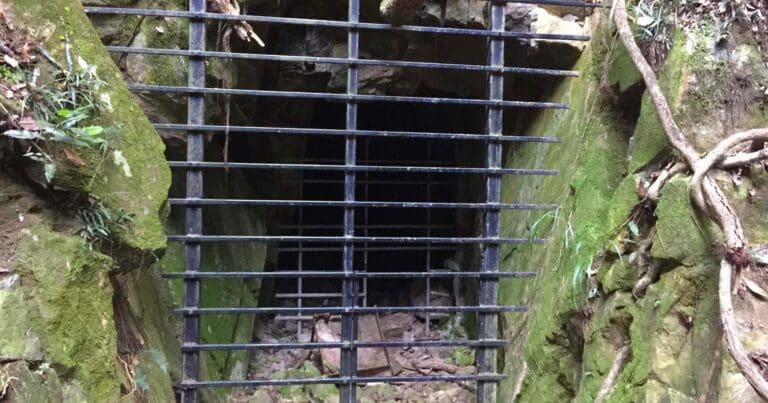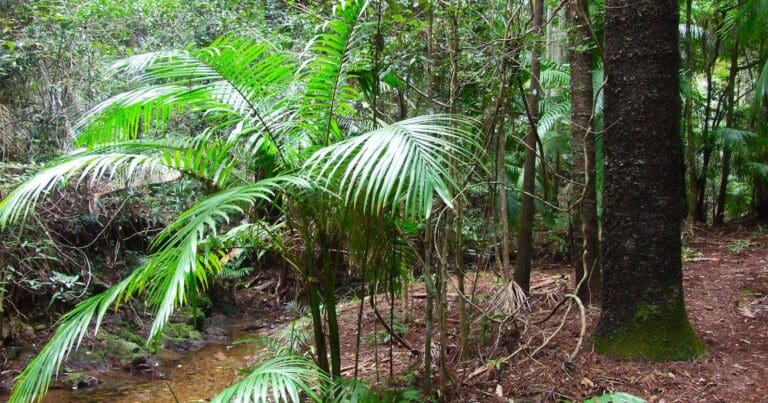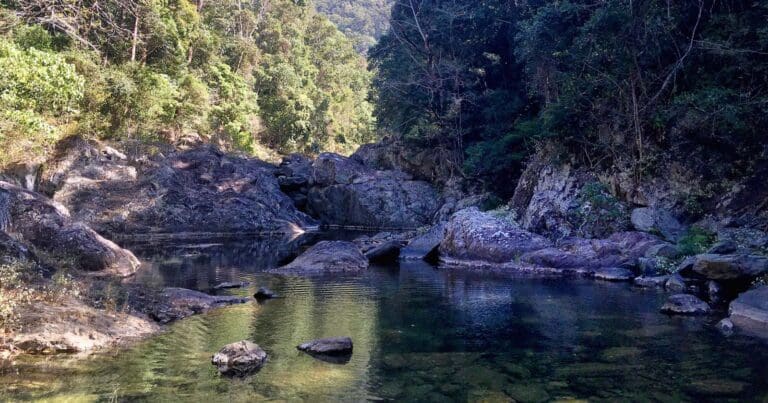Hike at a Glance
Max elevation: 214m
Min elevation: 156m
Total Ascent: 189m
Hike overview
Starting from the Booloumba Creek day-use area, this 6.5km return walk follows a section of the Conondale Range Great Walk, weaving through dense rainforest and alongside a gently flowing creek. The track leads to the Strangler Cairn, a striking 3.7-metre-high sculpture by internationally renowned artist Andy Goldsworthy. Constructed from carefully hand-cut granite and metamorphic stone, the cairn is topped with a strangler fig sapling, which will gradually envelop the structure over time. Goldsworthy’s work often explores the relationship between nature and impermanence, and this piece is no exception. As the years pass, the fig’s roots will slowly entwine and overtake the cairn, creating an evolving fusion of sculpture and landscape.
The walk itself is relatively moderate, though a reasonable level of fitness is recommended. The terrain varies, with a few short, steeper sections and some narrow parts of the track. There are four small rock staircases, each with about five steps, but nothing overly challenging. The path is well-formed and should be manageable for older children, around ten years and up, who will likely enjoy both the walk and the intrigue of the sculpture at the end.
For much of the walk, mobile phone reception is unreliable or non-existent, so switching your phone to airplane mode can help conserve battery life. With the rainforest canopy filtering the sunlight and the sound of the creek accompanying you along the way, this is a walk that offers both a sense of tranquillity and a rewarding destination. The Strangler Cairn is a rare blend of art and nature, a living sculpture that invites visitors to return over time and witness its transformation.
Gallery
Got some great shots from this hike? Upload your photos here to inspire others and show off the beauty of the trail!
Uploading your photos doesn’t mean you lose ownership. You can be credited for your contributions, and you can request removal at any time.
Content use
Please don’t copy GPX files or content from this site to AllTrails or other platforms. Each trail has been personally mapped, documented, and refined to support Australia’s bushwalking and hiking community. While some details come from land managers, every listing reflects significant personal effort. This is a free, community-driven initiative—your respect helps keep it that way.
Walk map and GPX file
Max elevation: 214 m
Min elevation: 156 m
Total climbing: 189 m
Total descent: -189 m
Getting there
Getting to the trailhead: Conondale National Park.
Getting to the Booloumba Gold Mine Walk requires a bit of planning, as the access roads are only suitable for high-clearance four-wheel-drive vehicles. From Brisbane, take the Bruce Highway north and exit toward Kenilworth, following the Eumundi-Kenilworth Road for about 28km. After passing through Kenilworth, continue toward Maleny for another 7km until you reach the turn-off to Sunday Creek Road, with the entrance to Booloumba Creek day-use and camping areas located just 500 metres beyond.
Alternatively, if you’re coming from Maleny, follow the signs toward Kenilworth, passing through the small town of Conondale. The turn-off to Booloumba Creek is about 13km past Conondale, with Sunday Creek Road a further 500 metres along. All park roads are unsealed, with creek crossings along Booloumba Creek Road, so a four-wheel-drive vehicle is essential. Booloumba Creek area roads include several natural creek crossings. Heavy rain can flood creek crossings. If it’s flooded, forget it! Wait it out. Visit the QLD parks and forests website for current Park alerts and closures.
If you’re looking for an alternative camping experience accessible by two-wheel-drive, nearby Charlie Moreland camping area in Imbil State Forest offers a similar setting and can be reached via Kenilworth or Conondale.
Closest towns to this walk: Conondale, Curramore, Flaxton, Kenilworth, Maleny, Mapleton, Montville, Nambour, Witta
Access conditions
- 4WD Access
- Gravel Road
- Vehicle Ford
- Large Car Park
- Public Toilets
- Untreated Water
- Camping Area
About the region
About 130 kilometres north of Brisbane, Conondale National Park stretches across 35,648 hectares in the Sunshine Coast Hinterland, protecting a diverse landscape of subtropical rainforest, woodlands, and sclerophyll forests. It is home to Queensland’s tallest tree and features pockets of regenerating forest, remnants of past logging operations. Bordering the park, former plantation areas hint at the region’s history of timber harvesting. Now managed under the Nature Conservation Act 1992, the park serves as a refuge for rare and threatened species while offering a rugged and unspoiled wilderness for those who seek to explore its remote trails and waterways.
The Conondale region has seen significant environmental change since the 1860s, with land clearing for agriculture, mining, and logging shaping much of the terrain. Despite these impacts, the park remains a sanctuary for a variety of species, including the plumed frogmouth, giant barred frog, Conondale crayfish, spotted-tailed quoll, Gympie nut, and Richmond birdwing butterfly. Conservation efforts focus on mitigating threats to their survival, ensuring these species continue to inhabit the area. Of particular historical interest is the southern gastric-brooding frog, which was once recorded in the park before mysteriously disappearing in 1981. Presumed extinct, its loss remains one of the more intriguing mysteries in Australian wildlife conservation.
The park’s rugged topography is defined by deep gorges, steep valleys, and peaks that rise above 700 metres, with Mount Langley standing as the highest at 868 metres. Numerous waterfalls, cascades, and boulder-strewn creeks weave through the landscape, providing vital water sources for local wildlife. Booloumba Creek Falls is among the park’s most striking natural features, offering a glimpse into the power and beauty of the waterways that have carved through the range over time. The Conondale Range forms a natural divide between the Brisbane and Mary River catchments, with the park’s southernmost tributaries feeding into Booloumba and Yabba creeks. These waterways play an important role in sustaining the critically endangered Mary River cod, a species that has seen significant decline in recent decades.
With an annual rainfall of around 1,500 millimetres, Conondale National Park experiences distinct seasonal variations. Heavy summer downpours between December and March bring lush growth and increased creek flows, while winters tend to be cool and dry, with occasional frosts settling across the higher elevations. The park’s vegetation is equally diverse, ranging from dense notophyll vine forests and subtropical rainforest to stands of Bangalow palms, wet and dry sclerophyll forests, and expansive woodlands. Rainforest is most commonly found at higher altitudes and along the waterways, creating a shifting mosaic of habitats that support an incredible variety of plant and animal life.
This rich natural landscape tells a story of resilience, change, and ongoing conservation efforts. Whether exploring its remote trails, pausing by a secluded waterfall, or simply taking in the dense, layered greenery of its forests, Conondale National Park offers a glimpse into a wild and ancient world that continues to evolve with each passing season.
Similar walks nearby
Looking for more walks in or near Conondale National Park? Try these trails with a similar difficulty grade.
Track grade
Grade 3 (Moderate) - Walks for Most Fitness Levels: Grade 3 on the AWTGS represents moderate walking tracks. These are ideal for walkers with some fitness who are comfortable with some hills and uneven terrain. While suitable for most ages, some bushwalking experience is recommended to ensure a safe and enjoyable experience. Tracks may have short, steep hill sections, a rough surface, and many steps. The total distance of a Grade 3 walk can be up to 20 kilometers.
Explore safe
Plan ahead and hike safely! Carry enough water, pack layers for changing conditions, and bring safety gear like a torch, PLB, and reliable communication device. Check official sources for trail updates, closures, and access requirements, and review local weather and bushfire advice. Most importantly, share your plans with someone before you go. Being prepared makes for a safer and more enjoyable hike! Stay Safe, Explore More, and Always #ExploreSafe.
Packing checklists
What you carry in your pack depends on factors like weather, terrain, and your adventure type. Not sure what to bring? My free planning, food, and packing checklists are a great starting point, covering day hikes, overnight trips, and multi-day adventures. Use them to customise your kit and always prioritise safety.
Let someone know
Before heading out, take a moment to fill out your trip intentions form. It’s a quick way to share your hike details with family or friends. If something goes wrong, they can notify emergency services, ensuring a faster response and peace of mind. Stay safe and enjoy your adventure
Suggest an edit
Spotted a change on this trail? Maybe there are new features, the route has shifted, or the trail is permanently closed. Whatever the update, I’d love your input. Your feedback helps fellow hikers stay informed and ensures that our trail info stays fresh and reliable.
Acknowledgement of Country
Trail Hiking Australia acknowledges the Traditional Owners of the lands on which we hike and pay respects to their Elders, past and present, and we acknowledge the First Nations people of other communities who may be here today.







6 Reviews on “Strangler© Cairn Walk (6.5km)”
You like your short walks don’t you
TJ Craig I like all walks. I try to cover everything from accessible walks to long distance trails so everyone has something to explore. Multi-day are my favourites though.